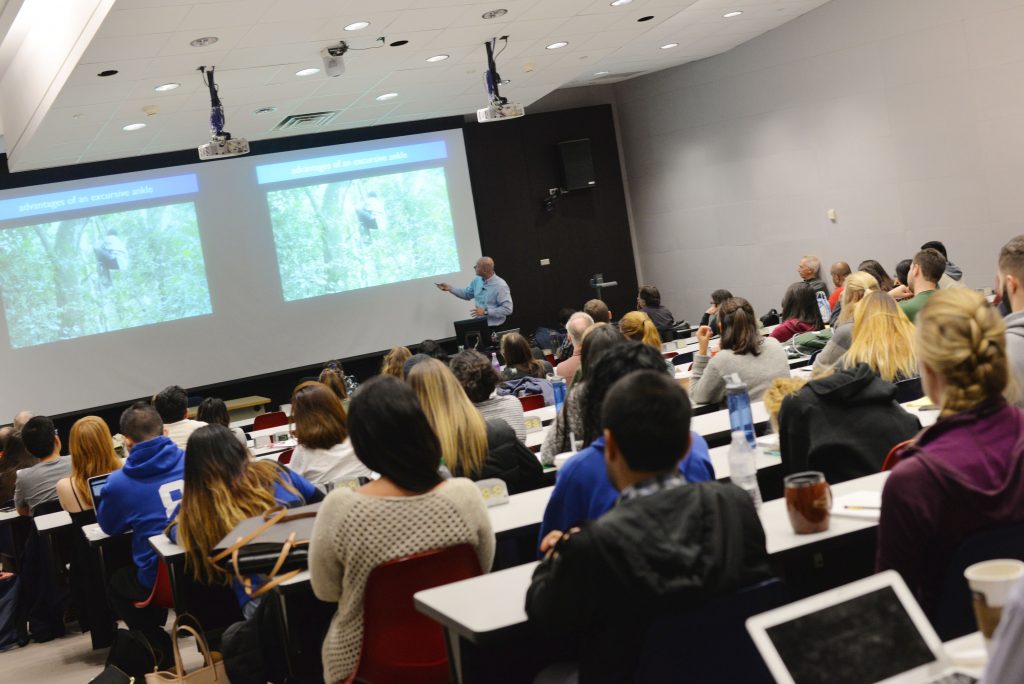
On Monday afternoon, Nathaniel Dominy spoke to students at Binghamton University about his research on the human pygmy phenotype as part of the evolutionary studies (EvoS) speaker series.
Dominy is a professor of anthropology and an adjunct professor of biological sciences at Dartmouth College. His talk focused on the foraging behaviors that various hunter-gatherer populations adopted as a result of their premature development. People who express the pygmy phenotype measure at a height no taller than 155 centimeters, or about 5 feet.
Dominy began by comparing the skeletal structure of the average human with that of a small hominid known as Homo floresiensis, or LB1. In his research, he has investigated the skull size of the typical human being with a skeleton belonging to a LB1 hominid. He attempted to decipher the implications that this cranial disparity could have on brain function.
“This specimen LB1 has a relatively short forehead, suggesting that the brain size is disproportionately smaller than the body size,” Dominy said. “The brain volume is estimated about one-third the volume you would expect for a hominid about 1 meter tall.”
Dominy said that these findings were surprising to the scientific community because pygmy populations, such as Homo floresiensis, have particular advantages in their environments.
He also discussed the active role of growth hormones in the expression of the pygmy phenotype, and how abnormalities in the levels of this hormone directly correlate with stunted growth.
“The first line of evidence comes from the hormonal profiles,” Dominy said. “So, all of these pygmy populations — those in Africa, Southeast Asia and South America — are united by having relatively low levels of growth hormone receptor.”
He explained that because the hormonal profiles in these three distinct regions around the world are shared, there must be some genetic mechanism regulating the expression of the growth hormone. Dominy’s findings are in accordance with the fact that these three populations convey a striking example of convergent evolution, meaning that they all independently evolved the pygmy trait while adapting to similar climates in distinct regions of the globe.
Dominy added that there is an emerging field of human immunological ecology that suggests the occurrence of fetal programming.
“If you take a mother who has been exposed to an environment full of pathogens throughout her adult life, her immune system is essentially primed to that kind of environment,” Dominy said. “She becomes pregnant, and then, through some process, her information is transferred to the developing fetus that conveys information about the hostility of that environment.”
Gabriel Valencia, a first-year graduate student studying biology, said that he learned something that he did not know about communities living in the rainforest. He shared his own experience with native populations in South America and said that it connected to Dominy’s talk.
“I come from Colombia, and I actually went to the Amazon and talked with some of the natives there,” Valencia said. “So it was interesting that we talked about that.”
David Wilson, director of the speaker series and a professor of biology and anthropology, talked about the importance of exposing undergraduate students to the graduate-style education that this program provides and said how beneficial it is to recognize the common theme of evolution in each talk presented by a speaker.
“Every single lecture, although it’s on a very different topic from week to week, is always from the same theoretical perspective of evolution,” Wilson said. “It’s like a single tool kit that can be applied to all topics, whether it’s humans or nonhumans. That’s the signature quality of EvoS.”


